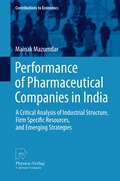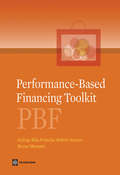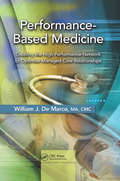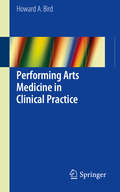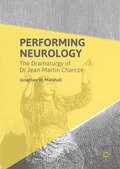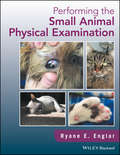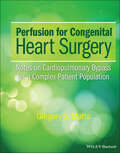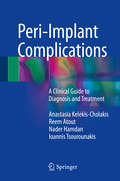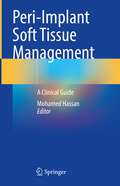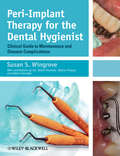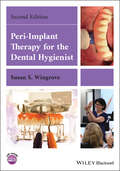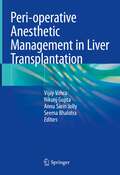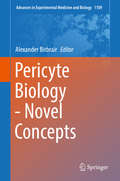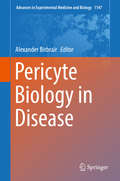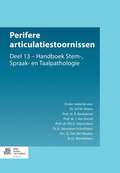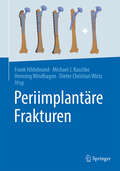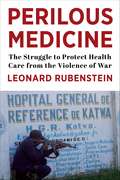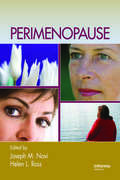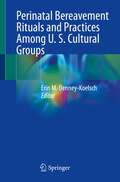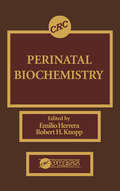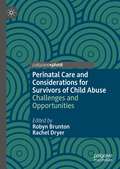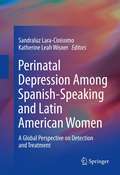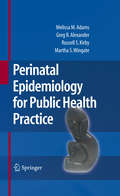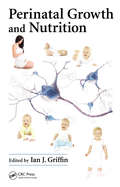- Table View
- List View
Performance of Pharmaceutical Companies in India: A Critical Analysis of Industrial Structure, Firm Specific Resources, and Emerging Strategies
by Mainak MazumdarThis book explains how government support and institutional set up facilitated the evolution of the Indian pharmaceutical industry and provides an economic analysis of firm strategies due to recent policy changes. The book is useful for researchers interested in understanding the transition of a lifeline sector for an emerging economy like India. Students of public policy, health administrators and health economists who are interested in the functioning of the pharmaceutical sector that produces life saving drugs in developing nations will find this book useful. The book also provides good coverage on data envelopment analysis (DEA), a useful technique for understanding productivity and efficiency. It can provide guidance to the research students on the applicability of DEA technique to address various research questions for analysis. The book will be a valuable addition to libraries in colleges of pharmacy and medicine as well as to all other academic and research centers.
Performance-Based Financing Toolkit
by Bruno Meessen Robert Soeters György Bèla FritschePerformance-based financing (PBF) approaches have expanded rapidly in lower-and middle income countries, and especially in Africa. The number of countries has grown from three in 2006 to 32 in 2013. PBF schemes are flourishing and cause considerable demand for technical assistance in executing these health reforms in a rational and accountable manner. Currently there is a lack of knowledge among many health reformers of how to implement performance-based financing pilot projects, and scale them up intelligently. In a context of tremendous demand for solid design and implementation experience and given the rapid expansion of results-based financing (RBF) programs, there is an urgent need to build capacity in designing and implementing PBF programs. As yet there has been little attempt to gather the learning from these experiences together in one volume and, moreover, in a form that serves as a guide to implementers. This toolkit answers the most pressing issues related to the supply-side RBF programs of which PBF forms part.
Performance-Based Medicine: Creating the High Performance Network to Optimize Managed Care Relationships
by MA, CMC, De MarcoWith healthcare making the transition from volume-based reimbursement programs to value-based approaches, understanding performance measurement is vital to optimize payment and quality outcomes. Performance-Based Medicine: Creating the High Performance Network to Optimize Managed Care Relationships guides readers through the maze of definitions and
Performing Arts Medicine in Clinical Practice
by Howard A. BirdFor many general practitioners, physiotherapists, osteopaths and chiropracters, patients with a background in performing arts account for only a small proportion of their practice. This simple primer assists the reader in the management of these highly complex (and sometimes highly strung) elite athletes. This book is pitched at the Masters level. A first degree in a medical speciality is assumed so space has not been allocated to the standard management of common conditions such as epicondylitis, carpal tunnel syndrome, ankle sprains of fractures. With some thirty years practical experience around the theme of "Controversies in Performing Arts Medicine", the editor has provided occupational rheumatological care for performing artists, especially instrumentalists and dancers with complex ailments. The introductory section provides a basic insight into the musculoskeletal problems specific to each of the many varied instruments and styles of dance. Consideration is also given to musculoskeletal aspects that affect the voice.
Performing Neurology
by Jonathan W. MarshallThis text provides a study of Jean-Martin Charcot, a founding figure in the history of neurology as a discipline and a colleague of Sigmund Freud. It argues that Charcot's diagnostic and pedagogic models, explaining both how disease is recognized and described and how to teach the act of neurological diagnosis, should be considered through a theatrical lens. Considering the constitution of the living, moving body in terms of performance, Charcot created a situation whereby the line between deceptive acting and real pathology, scientific accuracy and creative falsehood, and indeed between health and unhealth, becomes blurred. The physician becomes a medical subject in his or her own display, transforming medicine into a potentially destabilizing, even grand guignolesque, discourse. Offering a unique insight into Charcot's work, his concepts and his methods, this text represents a unique and interdisciplinary analysis cutting across the fields of art and neurology.
Performing the Large Animal Physical Examination
by Sarah Eaton Ryane E. Englar Gayle Leith Skyler Bentley Lisa HallamEasy-to-follow guide to performing physical examinations on horses and ruminants, with a comprehensive collection of color photographs demonstrating important concepts and procedural techniques. Featuring hundreds of full-color images demonstrating the observation and hands-on clinical skills described, Performing the Large Animal Physical Examination offers a step-by-step guide to all aspects of assessing the health and wellbeing of equine patients and ruminants. Cattle, sheep, and goats are emphasized, with vital commentary about camelids included when applicable. Each section begins with information on observing, approaching, and safely handling patients, then discusses how to systematically evaluate each body system. A companion website features video clips demonstrating key concepts. Performing the Large Animal Physical Examination includes information on: Equine and ruminant behavior, including feeding, social, herd, and separation behaviors, sleep and rest disturbances, other stereotypiesThe distance examination, observation, and efficient methods to approach and restrain patients, with emphasis on flight zones and point of balance, safety of personnel, and animal welfareBig picture considerations with respect to the patient’s body, coat, and skin, including coat color and markings, weight and height estimations, and forms of patient identificationEvaluation of the head (eyes, ears, nose, and throat) as well as the cardiovascular, respiratory, lymphatic, gastrointestinal, reproductive, musculoskeletal, and nervous systems, plus considerations specific to the lameness examBasic clinical procedures and common clinical conditions specific to each body system in horses, small and large ruminants Performing the Large Animal Physical Examination is an essential resource for students and other veterinary team members to develop comfort and confidence observing, approaching, handling, and examining equine and ruminant patients, as well as for experienced practitioners who may wish to refine their skills and clinical acumen.
Performing the Small Animal Physical Examination
by Ryane E. EnglarPerforming the Small Animal Physical Examination offers an easy-to-follow guide to successfully executing a thorough physical exam in cats and dogs, with nearly 1,000 clinical photographs depicting step-by-step details. Provides comprehensive, practical information on the physical examination in small animal patients Presents nearly 1,000 color photographs with step-by-step details of the procedures and principles Offers advice on preparing the examination room, useful tips, and concrete guidance for examining each body system Outlines a systematic, in-depth approach to the initial examination in dogs and cats Supports new and experienced veterinarians and veterinary technicians alike in performing a thorough basic exam
Perfusion for Congenital Heart Surgery
by Gregory S. MatteConfidently devise a safe and successful 'plan for the pump run' for patients undergoing surgery for congenital heart disease. This practical guide for perfusionists and other members of the cardiac surgical team provides information on the devices, technology and techniques required for successful bypass of patients with congenital heart defects A practical, spiral-bound, go-to reference designed to answer the most frequently-posed questions about bypass for CHD, the surgical treatment of which is often complicated Focuses on the latest technology and techniques and provides clear, matter-of-fact guidance based on specific diagnoses Written by a seasoned perfusionist who is co-chief and educator at one of the world's leading children's hospitals Spiral binding allows the book to be laid flat for easy referral in the operating room A notes section following each diagnosis enables readers to add institution and/or surgeon-specific information to tailor a bypass plan for each CHD lesion
Peri-Implant Complications: A Clinical Guide To Diagnosis And Treatment
by Anastasia Kelekis-Cholakis Reem Atout Nader Hamdan Ioannis TsourounakisThis book is an up-to-date reference that provides detailed guidance on how to diagnose and manage the soft and hard tissue complications that may be associated with a functioning dental implant placement, such as peri-implant mucositis, soft tissue loss, and peri-implantitis. Treatment options for each complication are described and illustrated step by step and carefully selected cases are presented to further explain the individual stages in management and to highlight key learning points. Practical advice is offered on all aspects of diagnosis, and information is also presented on the definition and etiology of the various complications. The book is in an easy-to-read format and includes a review of the latest literature on the topic.
Peri-Implant Soft Tissue Management: A Clinical Guide
by Mohamed HassanThis book provides dentists who place dental implants with a thorough overview of how to deal with the various challenges that they are likely to face in delivering appropriate soft tissue management. Various modalities and techniques for handling soft tissue during the surgical and restorative phases are clearly described, with discussion of different flap designs and the implications of the patient’s medical condition. Guidance is presented on subsequent oral hygiene measures and the management of common soft tissue pathologies that may arise around dental implants. In addition, the relationship between implant occlusion and soft tissues is examined. The book will be ideal for all practitioners and dental students and faculty at all levels who wish to learn more about the importance of the soft tissues in implant dentistry and the approaches that will contribute to optimal functional and aesthetic outcomes.
Peri-Implant Therapy for the Dental Hygienist
by Susan S. WingrovePeri-Implant Therapy for the Dental Hygienist is a comprehensive guide for implant history, prosthetic designs, and patient selection including oral systemic health and risk assessment. The text also discusses pre-surgical procedures, communicating with patients about implant dentistry, in-office maintenance protocols, plus new innovative home-care options to ensure success of the implant and overall health of the patient. An essential tool for dental hygienists to prepare to take on this very important challenge in the profession, Peri-Implant Therapy for the Dental Hygienist is a valuable resource for the entire dental team.
Peri-Implant Therapy for the Dental Hygienist: Clinical Guide To Maintenance And Disease Complications
by Susan S. WingrovePractical guidance for dental hygienists on how to maintain dental implants in daily practice The newly revised Second Edition of Peri-Implant Therapy for the Dental Hygienist provides a comprehensive guide to biofilm-focused assessment, maintenance, and home care for the prevention of long-term implant complications. The book offers clinical protocols ranging from single titanium and ceramic implant-borne restorations to the fixed full arch final prosthesis. The text also discusses pre-surgical regenerative procedures, implant placement, and patient communication to support hygienists and other dental professionals in talking to patients about implant dentistry. The book is a valuable clinically oriented resource guide for dental professionals seeing patients with titanium and ceramic dental implants. This new edition introduces readers to new information on ceramic implant instrumentation and ‘Mastering the Arch’, as well as detailed information on how to remove, assess, and provide maintenance for full arch prostheses patients. A new companion website provides dental instructor materials, review questions and answers, lesson plans, videos, PowerPoint slides, skills evaluations, and learning objectives. The book includes: Useful clinical photographs, illustrations, and patient cases to demonstrate the concepts discussed throughout the book Researched protocols for assessment, professional in-office maintenance, and biofilm-focused patient home care to meet all the peri-implant therapy challenges Updated classification, guidelines, and treatments for peri-implant disease Technology and resources for prevention of peri-implantitis and complications that can be prevented with early detection and patient awarenessIdeal for dental hygienists and dental hygiene and dental students, Peri-Implant Therapy for the Dental Hygienist is also an essential reference for any dental professional seeking a one-stop resource for maintaining dental implants and managing their complications.
Peri-operative Anesthetic Management in Liver Transplantation
by Vijay Vohra Nikunj Gupta Annu Sarin Jolly Seema BhalotraThe book covers all aspects of peri-operative anesthetic management of liver transplant patients. It provides a comprehensive coverage of the relevant history, surgeons’, hepatologists’, intensivists’ and pediatricians’ perspective of the disease, its pathogenesis, clinical presentation and indication for transplant. It discusses the practical aspects like fluid management and use of vasopressors. The book is divided into sections for a better and comprehensive delivery of information. Individual sections provide up to date information on the pre-operative issues and optimisation, intra-operative care and management and post-operative critical care issues and management of all transplant patients with special emphasis on recent advances. Separate sections cover ICU care of these patients in great detail and anesthetic management of pediatric liver transplant. The book includes anesthetic techniques involved in conducting multiorgan transplant. It discusses clinical approach to a patient with acute liver failure, brain death criteria and laws and organ donor management. It also presents newer techniques and methodologies adopted in the field of liver transplant. It includes ample illustrations, flowcharts, key points in each chapter, figures and photographs. The book contains chapters focusing on post-transplant patients presenting for non-transplant surgery. The book fills the gap in the literature for a comprehensive guide for the anesthetist performing or pursuing liver transplant, students/trainees/examinees who have a keen interest in this field and doctors dealing with such patients in critical care, donor management, pursuing general anesthesia. It is also helpful for hepatologists, intensivists and surgeons associated with liver transplant.
Pericyte Biology - Novel Concepts (Advances in Experimental Medicine and Biology #1109)
by Alexander BirbrairThis volume explores novel concepts of pericyte biology. The present book is an attempt to describe the most recent developments in the area of pericyte biology which is one of the emergent hot topics in the field of molecular and cellular biology today. Here, we present a selected collection of detailed chapters on what we know so far about the pericytes. Together with its companion volumes Pericyte Biology in Different Organs and Pericyte Biology in Disease, Pericyte Biology - Novel Concepts presents a comprehensive update on the latest information and most novel functions attributed to pericytes. To those researchers newer to this area, it will be useful to have the background information on these cells' unique history. It will be invaluable for both advanced cell biology students as well as researchers in cell biology, stem cells and researchers or clinicians involved with specific diseases.
Pericyte Biology in Disease (Advances in Experimental Medicine and Biology #1147)
by Alexander BirbrairThis volume explores pericytes' roles under distinct pathological conditions, ranging from tumors, ALS, Alzheimer’s disease, Multiple Sclerosis, stroke, diabetes, atherosclerosis, muscular dystrophies and more. Together with its companion volumes Pericyte Biology in Different Organs and Pericyte Biology – Novel Concepts, Pericyte Biology in Disease presents a comprehensive update on the latest information and most novel functions attributed to pericytes. To those researchers newer to this area, it will be useful to have the background information on these cells' unique history. It will be invaluable for both advanced cell biology students as well as researchers in cell biology, stem cell biology and clinicians involved with these specific diseases.
Perifere articulatiestoornissen: Deel 13 - Handboek Stem-, Spraak- en Taalpathologie
by R. Bastiaanse P.H.O. Dejonckere K. Jansonius-Schultheiss B.J.E. Mondelaers H.F.M. Peters J. Van Borsel Sj. Van der MeulenHet Handboek Stem-Spraak-Taalpathologie verscheen tussen 1997 en 2007 gefaseerd in losse afleveringen. Daarin werd alle kennis op het gebied van de stem-, spraak- en taalpathologie vanuit verschillende disciplines samengebracht. Het Handboek is bestemd voor iedereen die klinisch-praktisch of meer theoretisch is geïnteresseerd, of vanuit een ander vakgebied hiermee in aanraking komt. Voor logopedisten, artsen, linguïsten, spraak- en taalpathologen, audiologen, pedagogen en psychologen in Nederland en België is het Handboek een onmisbare vraagbaak.Deel 13 is geheel gewijd aan Perifere articulatiestoornissen.
Periimplantäre Frakturen
by Katja DalkowskiSchwerpunkt dieses Buches ist eine strukturierte und praxisorientierte Darstellung der Behandlung periimplantärer und periprothetischer Frakturen. Im allgemeinen Teil werden die epidemiologischen Grundlagen sowie die wesentlichen Klassifikationssysteme beschrieben. Darüber hinaus erfolgt die Darstellung der Grundprinzipien der osteosynthetischen und endoprothetischen Versorgung. Im speziellen Teil liegt der Schwerpunkt darauf, die Spezifika der Behandlung periprothetischer Frakturen an Hand von Fallbeispielen zu zeigen. So werden für alle großen Gelenke Operationsindikationen und -techniken, inklusive der Lösungsoptionen bei komplikativen Verläufen, vorgestellt. Dabei wird zwischen Frakturen unterschieden, die intraoperativ im Rahmen der Prothesenimplantation oder traumatisch bei einliegender Endoprothese entstanden sind. Unsere Autoren zeigen innovative Sonderlösungen, die z.T. von den üblichen Lehrbuchstandards abweichen können.
Perilous Medicine: The Struggle to Protect Health Care from the Violence of War
by Leonard RubensteinPervasive violence against hospitals, patients, doctors, and other health workers has become a horrifically common feature of modern war. These relentless attacks destroy lives and the capacity of health systems to tend to those in need. Inaction to stop this violence undermines long-standing values and laws designed to ensure that sick and wounded people receive care.Leonard Rubenstein—a human rights lawyer who has investigated atrocities against health workers around the world—offers a gripping and powerful account of the dangers health workers face during conflict and the legal, political, and moral struggle to protect them. In a dozen case studies, he shares the stories of people who have been attacked while seeking to serve patients under dire circumstances including health workers hiding from soldiers in the forests of eastern Myanmar as they seek to serve oppressed ethnic communities, surgeons in Syria operating as their hospitals are bombed, and Afghan hospital staff attacked by the Taliban as well as government and foreign forces. Rubenstein reveals how political and military leaders evade their legal obligations to protect health care in war, punish doctors and nurses for adhering to their responsibilities to provide care to all in need, and fail to hold perpetrators to account.Bringing together extensive research, firsthand experience, and compelling personal stories, Perilous Medicine also offers a path forward, detailing the lessons the international community needs to learn to protect people already suffering in war and those on the front lines of health care in conflict-ridden places around the world.
Perimenopause
by Joseph M. Novi Helen L. RossA simple and accessible reference that is perfect for the busy gynecologist or obstetrician in clinical practice, Perimenopause presents a comprehensive discussion on the various issues affecting menopausal women. Each chapter contains handy quick-tab-tables to swiftly locate diagnoses and treatment methodologies.Key topics in the text include:gene
Perinatal Bereavement Rituals and Practices Among U. S. Cultural Groups
by Erin M. Denney-KoelschDeath rituals are a universal feature of every human culture across the world. Every human must eventually face the stark reality of death, and many cultures and religions have sought to make sense of death and bring solace to the people through bereavement rituals. Infant death has been commonplace in most of human history. Despite the high prevalence of pregnancy loss (25% of all pregnancies) and infant death (0.6% of liveborn infants), these deaths are rarely discussed openly. The parents’ grief often is underestimated or ignored by their social network who may never have met the baby and/or feel uncomfortable discussing the loss of a child. On the other hand, the families enduring perinatal loss experience profound grief, loss of the actual and imagined future for that child, and the baby is never forgotten. Thus, parents seek to have their baby remembered through the creation of keepsakes, memories, and rituals. Having a supportive environment that honors their loss and their child’s memory and helps to facilitate meaningful rituals can have a profound effect on their long-term bereavement.There is a large amount of literature on death rituals across cultures but most books include infants only briefly and miscarried or stillborn babies are not mentioned at all. This text seeks to fill this substantial gap through review of existing literature paired with dozens of interviews with clinicians and caregivers across many disciplines in the hospital and community as well as bereaved family members who have gone through perinatal loss. The authors recruited in Bereavement Rituals after Pregnancy Loss or Infant Death across U.S. Cultures are a broad group of experts that include clinicians in palliative care and perinatal bereavement, nurses and clergy from different religious groups. The book is broken up into three main sections. The first provides a history and theoretical basis for perinatal death rituals. The second includes an overview of common beliefs and practices in major US religious and cultural groups. The third focuses on the roles of the health care team members and offers a practical how-to guide for health care providers to support families through rituals that fit their personal values and needs.
Perinatal Biochemistry
by Emilio Herrera Robert H. KnoppIntrauterine development and birth constitute an uninterrupted sequence of events that have a molecular physiologic background. Perinatal Biochemistry presents a comprehensive review of this subject. Specific topics addressed include maternal metabolism during pregnancy, maternal insulin resistance, embryonic and fetal metabolism and fuel consumption, the fetal pancreas, growth factors, brain metabolism, and biochemical adaptations to early extrauterine life. The book will be useful to biochemists and physiologists interested in perinatology; clinicians working in areas related to maternal health, gestational development, and delivery; gynecologists, neonatologists; pediatricians; endocrinologists; and internists.
Perinatal Care and Considerations for Survivors of Child Abuse: Challenges and Opportunities
by Rachel Dryer Robyn BruntonThis edited collection collates research concerning the challenges and opportunities of pregnancy and the postpartum period for perinatal women who are survivors of child abuse. Drawing on empirical findings and theory, this is the first book to identify emerging and topical issues around screening and disclosure and how clinicians and professionals may help to build resilience for child abuse survivors. Pregnancy and the postpartum period present unique challenges and opportunities for clinicians and mental health professionals who may encounter pregnant women with adverse childhood experiences. Challenges include antenatal care considerations for survivors of child abuse such as triggering events that may further traumatize women or result in avoidance behaviours such as failing to engage in routine antenatal care, and other associated adverse outcomes including increased health concerns and, in some cases, prolonged labour and preterm birth. These challenges point to the need for identifying women at risk and providing sensitive care, and this book demonstrates the opportunities which arise through interventions and resilience building.
Perinatal Depression among Spanish-Speaking and Latin American Women: A Global Perspective on Detection and Treatment
by Sandraluz Lara-Cinisomo Katherine Leah WisnerPerinatal Depression among Spanish-Speaking and Latin American Women A Global Perspective on Detection and Treatment Sandraluz Lara-Cinisomo and Katherine Leah Wisner, editors As more is known about postpartum depression, the more it is recognized as a global phenomenon. Yet despite the large numbers, information about this condition as experienced by Spanish speaking women and Latinas has not always been easy to come by. Perinatal Depression among Spanish-Speaking and Latin American Women focuses on four diverse Latina populations (Mexico, Chile, Spain, and U.S.) to analyze key similarities and differences within this large and wide-ranging group. This first-of-its-kind reference reviews current research on the topic, including prevalence, screening methods, interventions, and--of particular salience for this population--barriers to care. Findings on psychoeducation, assessment tools, and cognitive-behavioral and other forms of therapy provide important insights into best practices, and continuity of care. And psychosocial, cultural, and linguistic considerations in working with Latinas are described in depth for added clinical usefulness. This landmark volume: Outlines characteristics of Spanish-speaking women and Latinas screened for postpartum depressionIntroduces the Edinburgh Postnatal Depression Scale, English and Spanish versions, and reviews their use with Latina womenCompares postpartum depression and health behaviors in Spanish and Latina immigrant mothersOffers streamlined assessment-to-intervention modelsProvides two in-depth case studies illustrating cultural factors influencing the treatment of Latinas with perinatal depression.Presents an instructive firsthand account of postpartum depression. Between its thorough coverage of the issues and its innovative clinical ideas, Perinatal Depression among Spanish-Speaking and Latin American Women has a wealth of information of interest to researchers and practitioners in maternal and child health, obstetrics/gynecology, mental health, and women's health.
Perinatal Epidemiology for Public Health Practice
by Mary Slay Wingate Melissa M. Adams Greg R. Alexander Russell S. KirbyPerinatal Epidemiology synthesizes perinatal knowledge through the lens of public health practice. This comprehensive text uses a consistent, logical format to offer readers: (1) A spectrum of topics affecting maternal and infant health: reproductive health concerns, maternal and infant morbidity and mortality, and gestation and fetal growth. (2) Information on timely issues, including infertility, gestational diabetes, preterm delivery, postpartum depression, and SIDS. (3) Detailed discussions of current epidemiological trends, measures and measurement issues, data sources, and risk and protective factors for each condition covered. (4) In-depth consideration of public health interventions and their availability, strengths and limitations. (5) Emerging areas of interest and directions for research. (6) Text boxes, definitions of key terms, discussion questions, appendices, and other helpful features. Perinatal Epidemiology is a valuable, ready resource for public health professionals in maternal and child care, reproduction and fertility. Its accessibility and easy-use format make it an equally strong textbook for courses in these fields as well as for advanced medical and nursing students in OB/GYN and pediatrics.
Perinatal Growth and Nutrition
by Ian J. GriffinPreterm infants grow poorly after birth and very commonly develop ex utero growth restriction (EUGR). However, the risks and benefits of catch-up growth in preterm infants must be weighed, and evidence addressing this warrants examination. Perinatal Growth and Nutrition explores the reasons for EUGR and the long-term effects on developmental outcom
